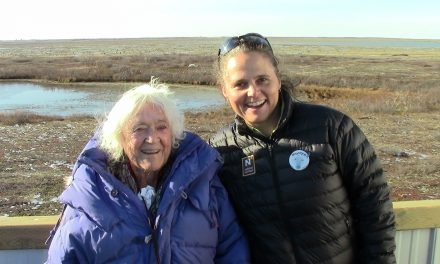
An escaped cod from a trap in a Newfoundland fishery heads straight for the bottom, mirroring the sharp drop in population numbers. ©Derek Keats, flickr
Warming ocean temperatures are diminishing the number of polar bears, causing a loss of Arctic sea ice and breaking up the East Antarctica ice sheet. While those facts about the poles get a lot of play in the news, they can seem far removed from the concerns of our lives in the United States, located far away.
But according to a recent scientific symposium and published paper, warming ocean temperatures will soon impact what’s on many of our dinner plates.
Cod has been caught on the U.S. East Coast since the Pilgrims landed—and before. In fact, reports about the amount of fish in those waters were one of the reasons many initially set out for North America. Early Cape Cod residents traded cod for goods overseas, and the industry boomed.

Atlantic cod is often the fish in the popular dish “fish and chips.” ©Mickey, flickr
Today, however, the Gulf of Maine, which stretches from Nova Scotia to Cape Cod, is warming faster than 99 percent of the rest of the oceans. And it’s happening so quickly that cod, a cold-water fish, cannot replace its numbers. Since 1982, Gulf of Maine cod have declined by 90 percent, with a drop of 77 percent in the past five years alone.
Some say banning cod fishing completely and immediately is the only way to save the species. Others worry that such a drastic measure would mean economic disaster for many places on the East Coast.
So, what should we value more: the persistence of a species or avoiding the collapse of local economies?

Reports about numerous cod were one of the reasons many initially set out for North America. ©Per Harald Olsen/NTNU, flickr
Matching cod decline to warming waters
Cod has a flaky, dense, white flesh and a mild flavor, making this low-fat fish a popular food in countries such as the U.S., Portugal and Spain. In England, Atlantic cod is one of the most common kinds of fish to be found in the nation’s iconic fish and chips. Cod livers are processed to make cod liver oil, a nutritional supplement worldwide.
On October 29, 2015, a scientific symposium commemorating the 50th anniversary of the first official climate-change warning to a U.S. president was held in Washington, D.C. On that same day, a paper was published in the online journal Science titled “Slow adaptation in the face of rapid warming leads to collapse of the Gulf of Maine cod fishery.” The lead author, Andrew Pershing, the chief scientific officer of the Gulf of Maine Research Institute, and his team examined satellite data on sea-surface temperatures dating from 1982. They calculated that the temperature in the gulf has been rising by 0.03 degrees Centigrade per year, compared to 0.01 degree globally. To see what drove that trend, the team correlated quarterly Gulf of Maine temperatures over that time frame with large-scale climate factors. They found that a northward shift of the Gulf Stream, a warm ocean current, hit the New England Coast at the same time that two, decade-long ocean climate cycles—the Atlantic Multidecadal Oscillation and the Pacific Decadal Oscillation—entered a warmer phase.
The researchers then referred to data as far back as 1900 and found that the chance of any similar segment of the ocean warming so fast was less than 0.3 percent. Previous research had linked the Gulf Stream’s gradual northward shift over the 20th century to increasing greenhouse gases in the atmosphere, resulting in a warming that few marine ecosystems have ever encountered.

The Gulf of Maine commercial cod catch has steadily declined since the 1990s. ©National Marine Fisheries Service, NOAA and latimesgraphics
Using recent Gulf of Maine cod stock assessments, the researchers tested a number of models for predicting the factors that affected cod reproduction. Warming turned out to be the best predictor: when summer temperatures went up, the number of fish reaching maturity went down. Of course, to maintain a population and sustain a fishery, new fish must be coming in.
Making cod come back
Two decades ago, commercial fishermen in the Gulf of Maine hauled in 30.5 million pounds of cod annually. In 2009, they caught 13.1 million pounds. Last year, the catch was down to just two million pounds of cod.
Recently, hundreds of Cape Cod fishermen who used to spend a whole year catching cod have given up fishing in the winter to work in construction; others have left the industry entirely. Some have switched to dogfish and skate, which are often canned and shipped to Europe. Unfortunately, the dogfish market is so saturated that fishermen only get around 20 cents a pound. By contrast, cod garners $4.50 a pound.

The cod fishery in Newfoundland closed in 1992. By then, the once-plentiful fish were near extinction, and officials feared they would vanish entirely if the fisheries remained open. About 30,000 people in the province were put out of work. ©michael_swan, flickr
Will New England still be New England without cod? Scientists say that if there is a complete closure of the U.S. cod fishery now, such as the one that took place in Newfoundland in 1992, Gulf of Maine cod could rebound in 11 years. If some fishing were allowed, recovery would take longer: from 14 to 19 years, depending on how fast ocean water warms.
It seems that, increasingly, we are being faced with making trade-offs among choices such as conserving a species, honoring a historic way of life or preserving a local economy. Last week, I wrote to you about the link between climate change and a distant war. Little did I realize that climate change would so soon be scientifically connected to what’s on our dinner tables.
Do you think the U.S. cod fishery should be closed completely to allow cod to rebound, or should local economies be allowed some time to reconfigure? Are we in the U.S. more likely to take rapid climate change more seriously if our popular foods are impacted?
Here’s to finding your true places and natural habitats,
Candy


































